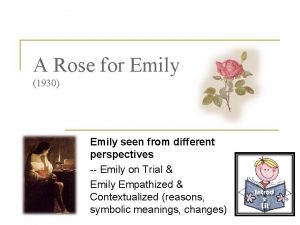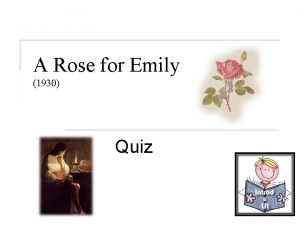A Rose for Emily Class Discussion Emily seen










- Slides: 10

A Rose for Emily Class Discussion Emily seen from Multiple Perspectives

Discussion Questions 1. One Group: Is the ending too sensational? Why did Emily Grierson murder her lover? Did she really kill him? How would you re-write the story? 2. Two Groups: Performing a Scene: Is Emily a victim or a heroine? 3. One Group: How do you characterize the narrators? Does it make a difference if they are women, or men? Do you have a similar experience of being part of an observing/gossipy public? 4. Two Groups: Emily—Guilty or not?

Review (1): Why can’t they get married? n n Homer Barron – pars 30; 42 – “he liked men. ” The town people’s intervention and their changes: q q q Happy that she ‘[has] an interest”; par 31 “Poor Emily” par 31 (He is not a good match for her nobility. ) Gossiping Disagree with the couple: their being together, without getting married. Par 32 Repeated par 43 (“She will persuade him” disagrace) Sent for the cousins (par 46) By that time it was a cabal, and we were all Miss Emily’s allies to help circumvent the cousins.

Review (2): Emily in Different (a)scene: As an old lady, she is noble n. Scenes Tax payment and proud on the one hand, stubborn, lifeless and unwilling to adjust to the changes of time on the other. q q Writes in a thin, flowing calligraphy in faded ink; (par 4) Image (1): "a small, fat woman in black, with a thin gold chain descending to her waist and vanishing into her belt, leaning on an ebony cane with a tarnished gold head. “ (par 6) She looked bloated, like a body long submerged in motionless water, and of that pallid hue. Her eyes, lost in the fatty ridges of her face, looked like two small pieces of coal pressed into a lump of dough”. “(par 6) Image (2, 3): More description of her motionlessness as an idol and carven torso (pars 24, 51)

Review: Emily in Different Scenes (b)Emily as a young woman n n Image (3) – tableau: As a young lady: controlled stubborn, passionate, with a strong will and -refusing to face death or obsessed by the corpses (necrophilia)? Image (4): Controlled by her father “like a girl” after her father’s death.

Review: Emily in Different Scenes (c)Emily with Homer Barron n Image (5): the thin, swift clop-clop of the matched team passed n Image (6): lighthouse watcher Stubbornness: the arsenic episode;

Review (3): The Narrator’s views of Emily? I. III. When Emily becomes a spinster – par 25; So when she got to be thirty and was still single, we were not pleased exactly, but vindicated; even with insanity in the family she wouldn't have turned down all of her chances if they had really materialized. ” When she loses her father pars 26, 29 -- “We did not say she was crazy then. We believed she had to do that. ” sympathetic [discussed already] the town people’s intervention into a) her love, b) her smell, c) her tax, d) the postal service.

Review (3): Are they Reliable Narrators? n n n Judgmental, intervening and sympathetic (par 47 – Emily disappears for 6 months) Then we knew that this was to be expected too; as if that quality of her father which had thwarted her woman’s life so many times had been too virulent and too furious to die. sympathy or wrong judgment? (par 48) When we next saw Miss Emily, she had grown fat and her hair was turning gray. During the next few years it grew grayer and grayer until it attained an even pepper-and-salt iron-gray, when it ceased turning. Up to the day of her death at seventy-four it was still that vigorous iron-gray, like the hair of an active man.

Debate: Emily Guilty or not? Pro: killing a person, obsessiveness, etc. Con: not her fault, no other choice, etc.

Main Argument n n Although Emily’s house, her figure and her action of killing for love can be scary, it is actually the town people’s intervention that is more scary. A more sympathetic view (rose) can be given to Emily when we understand the social constraints imposed on her. Another possible argument?



















